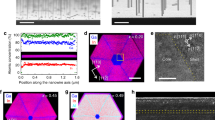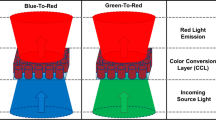Abstract
The III nitrides have been intensely studied in recent years because of their huge potential for everything from high-efficiency solid-state lighting and photovoltaics to high-power and temperature electronics1,2,3. In particular, the InGaN ternary alloy is of interest for solid-state lighting and photovoltaics because of the ability to tune the direct bandgap of this material from the near-ultraviolet to the near-infrared region. In an effort to synthesize InGaN nitride, researchers have tried many growth techniques4,5,6,7,8,9,10,11,12,13. Nonetheless, there remains considerable difficulty in making high-quality InGaN films and/or freestanding nanowires with tunability across the entire range of compositions. Here we report for the first time the growth of single-crystalline InxGa1−xN nanowires across the entire compositional range from x=0 to 1; the nanowires were synthesized by low-temperature halide chemical vapour deposition9 and were shown to have tunable emission from the near-ultraviolet to the near-infrared region. We propose that the exceptional composition tunability is due to the low process temperature and the ability of the nanowire morphology to accommodate strain-relaxed growth14, which suppresses the tendency toward phase separation that plagues the thin-film community.
This is a preview of subscription content, access via your institution
Access options
Subscribe to this journal
Receive 12 print issues and online access
$259.00 per year
only $21.58 per issue
Buy this article
- Purchase on Springer Link
- Instant access to full article PDF
Prices may be subject to local taxes which are calculated during checkout




Similar content being viewed by others
References
Schubert, E. F. & Kim, J. K. Solid-state light sources getting smart. Science 308, 1274–1278 (2005).
Wu, J. et al. Superior radiation resistance of In1−xGaxN alloys: Full-solar-spectrum photovoltaic material system. J. Appl. Phys. 94, 6477–6482 (2003).
Kung, P. & Razeghi, M. III-Nitride wide bandgap semiconductors: A survey of the current status and future trends of the material and device technology. Opto-Electron. Rev. 8, 201–239 (2000).
Schenk, H. P. D. et al. Indium incorporation above 800 ∘C during metalorganic vapor phase epitaxy of InGaN. Appl. Phys. Lett. 75, 2587–2589 (1999).
Shan, W. et al. Optical properties of InxGa1−xN alloys grown by metalorganic chemical vapor deposition. J. Appl. Phys. 84, 4452–4458 (1998).
Shimizu, M., Hiramatsu, K. & Sawaki, N. Metalorganic vapor phase epitaxy growth of (InxGa1−xN/GaN)n layered structures and reduction of indium droplets. J. Cryst. Growth 145, 209–213 (1994).
Yoshimoto, N., Matsuoka, T., Sasaki, T. & Katsui, A. Photoluminescence of indium gallium nitride films grown at high temperature by metalorganic vapor phase epitaxy. Appl. Phys. Lett. 59, 2251–2253 (1991).
Wu, J. et al. Small band gap bowing in In1−xGaxN alloys. Appl. Phys. Lett. 80, 4741–4743 (2002).
Takahashi, N., Matsumoto, R., Koukitu, A. & Seki, H. Vapor-phase epitaxy of InxGa1−xN using chloride sources. J. Cryst. Growth 189–190, 37–41 (1998).
Davydov, V. Y. et al. Band gap of hexagonal InN and InGaN alloys. Phys. Status Solidi B 234, 787–795 (2002).
Morkoc, H. Nitride Semiconductors and Devices (Springer, Berlin, 1999).
Perkins, N. R. et al. Growth of thick GaN films by halide vapor phase epitaxy. Proc. Electrochem. Soc. 96-5, 336–341 (1996).
Lu, D. et al. Dynamic scaling of the growth process of GaN thin films deposited on sapphire substrates by HVPE. Phys. Lett. A 327, 78–82 (2004).
Liliental-Weber, Z. et al. Compositional modulation in InxGa1−xN: TEM and X-ray studies. J. Electron Microscopy 54, 243–250 (2005).
Kuykendall, T. et al. Crystallographic alignment of high-density gallium nitride nanowire arrays. Nature Mater. 3, 524–528 (2004).
Sun, Y., Cho, Y.-H., Kim, H.-M. & Kang, T. W. High efficiency and brightness of blue light emission from dislocation-free InGaN/GaN quantum well nanorod arrays. Appl. Phys. Lett. 87, 093115 (2005).
Ertekin, E., Greaney, P. A., Chrzan, D. C. & Sands, T. D. Equilibrium limits of coherency in strained nanowire heterostructures. J. Appl. Phys. 97, 114325 (2005).
Fuhrmann, D. et al. Optimization scheme for the quantum efficiency of GaInN-based green light-emitting diodes. Appl. Phys. Lett. 88, 071105 (2006).
Fuhrmann, D. et al. Optimizing the internal quantum efficiency of GaInN SQW structures for green light emitters. Phys. Status Solidi C 3, 1966–1969 (2006).
Qian, F., Gradecak, S., Li, Y., Wen, C.-Y. & Lieber, C. M. Core/Multishell nanowire heterostructures as multicolor, high-efficiency light-emitting diodes. Nano Lett. 5, 2287–2291 (2005).
Kim, H.-M. et al. High-brightness light emitting diodes using dislocation-free indium gallium nitride/gallium nitride multiquantum-well nanorod arrays. Nano Lett. 4, 1059–1062 (2004).
Kim, H.-M. et al. Formation of InGaN nanorods with indium mole fractions by hydride vapor phase epitaxy. Phys. Status Solidi B 241, 2802–2805 (2004).
Kumagai, Y., Takemoto, K., Hasegawa, T., Koukitu, A. & Seki, H. Thermodynamics on tri-halide vapor-phase epitaxy of GaN and InxGa1−xN using GaCl3 and InCl3 . J. Cryst. Growth 231, 57–67 (2001).
Scholz, F. et al. Low pressure MOVPE of GaN and GaInN/GaN heterostructures. J. Cryst. Growth 170, 321–324 (1997).
Doppalapudi, D., Basu, S. N., Ludwig, K. F. Jr & Moustakas, T. D. Phase separation and ordering in InGaN alloys grown by molecular beam epitaxy. J. Appl. Phys. 84, 1389–1395 (1998).
Yang, B. et al. Structural and optical properties of GaN layers directly grown on 6H-SiC(0001) by plasma-assisted molecular beam epitaxy. Mater. Sci. Forum 264–268, 1235–1238 (1998).
Snyder, R. L., Fiala, J. & Bunge, H. J. (eds) Defect and Microstructure Analysis by Diffraction (Int. Union Crystallogr. Monogr. Crystallogr., Vol. 10, Oxford Univ. Press, Oxford, 1999).
Mattila, T. & Zunger, A. Predicted bond length variation in wurtzite and zinc-blende InGaN and AlGaN alloys. J. Appl. Phys. 85, 160–167 (1999).
Ho, I. H. & Stringfellow, G. B. Solid phase immiscibility in GaInN. Appl. Phys. Lett. 69, 2701–2703 (1996).
Caetano, C., Teles, L. K., Marques, M., Dal Pino, A. Jr & Ferreira, L. G. Phase stability, chemical bonds, and gap bowing of InxGa1−xN alloys: Comparison between cubic and wurtzite structures. Phys. Rev. B 74, 045215 (2006).
Liliental-Weber, Z. et al. Relaxation of InGaN thin layers observed by X-ray and transmission electron microscopy studies. J. Electron. Mater. 30, 439–444 (2001).
Stach, E. A. et al. Watching GaN nanowires grow. Nano Lett. 3, 867–869 (2003).
Waltereit, P. et al. Nitride semiconductors free of electrostatic fields for efficient white light-emitting diodes. Nature 406, 865–868 (2000).
Shubina, T. V. et al. Mie resonances, infrared emission, and the band gap of InN. Phys. Rev. Lett. 92, 117407 (2004).
Wu, J. et al. Effects of the narrow band gap on the properties of InN. Phys. Rev. B 66, 201403 (2002).
Acknowledgements
This work was supported in part by the US Department of Energy and DARPA-UPR. Work at the Lawrence Berkeley National Laboratory was supported by the Office of Science, Basic Energy Sciences, Division of Materials Science of the US Department of Energy. We thank T. Umbach, P. Pauzauskie and S.-Y. Bae for discussion, and the National Center for Electron Microscopy for the use of microscope facilities.
Author information
Authors and Affiliations
Corresponding author
Supplementary information
Supplementary Information
Supplementary figure S1 (PDF 1869 kb)
Rights and permissions
About this article
Cite this article
Kuykendall, T., Ulrich, P., Aloni, S. et al. Complete composition tunability of InGaN nanowires using a combinatorial approach. Nature Mater 6, 951–956 (2007). https://doi.org/10.1038/nmat2037
Received:
Accepted:
Published:
Issue Date:
DOI: https://doi.org/10.1038/nmat2037
This article is cited by
-
Solar-to-hydrogen efficiency of more than 9% in photocatalytic water splitting
Nature (2023)
-
Magnetization–structure–composition phase diagram mapping in Co-Fe-Ni alloys using diffusion multiples and scanning Hall probe microscopy
Scientific Reports (2022)
-
Nonpolar AlxGa1−xN/AlyGa1−yN multiple quantum wells on GaN nanowire for UV emission
Nano Research (2022)
-
Inter-facet composition modulation of III-nitride nanowires over pyramid textured Si substrates by stationary molecular beam epitaxy
Nano Research (2021)
-
Catalyst-assisted growth of InGaN NWs for photoelectrochemical water-splitting applications
Ionics (2020)



